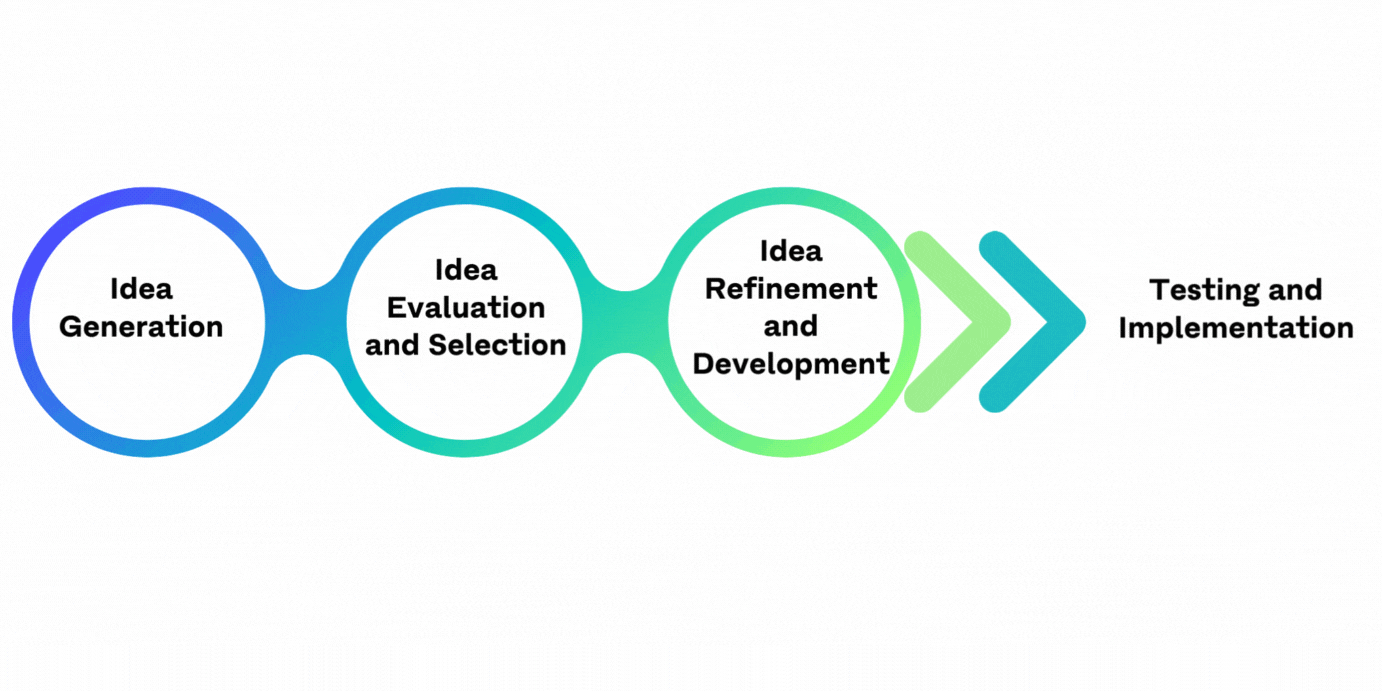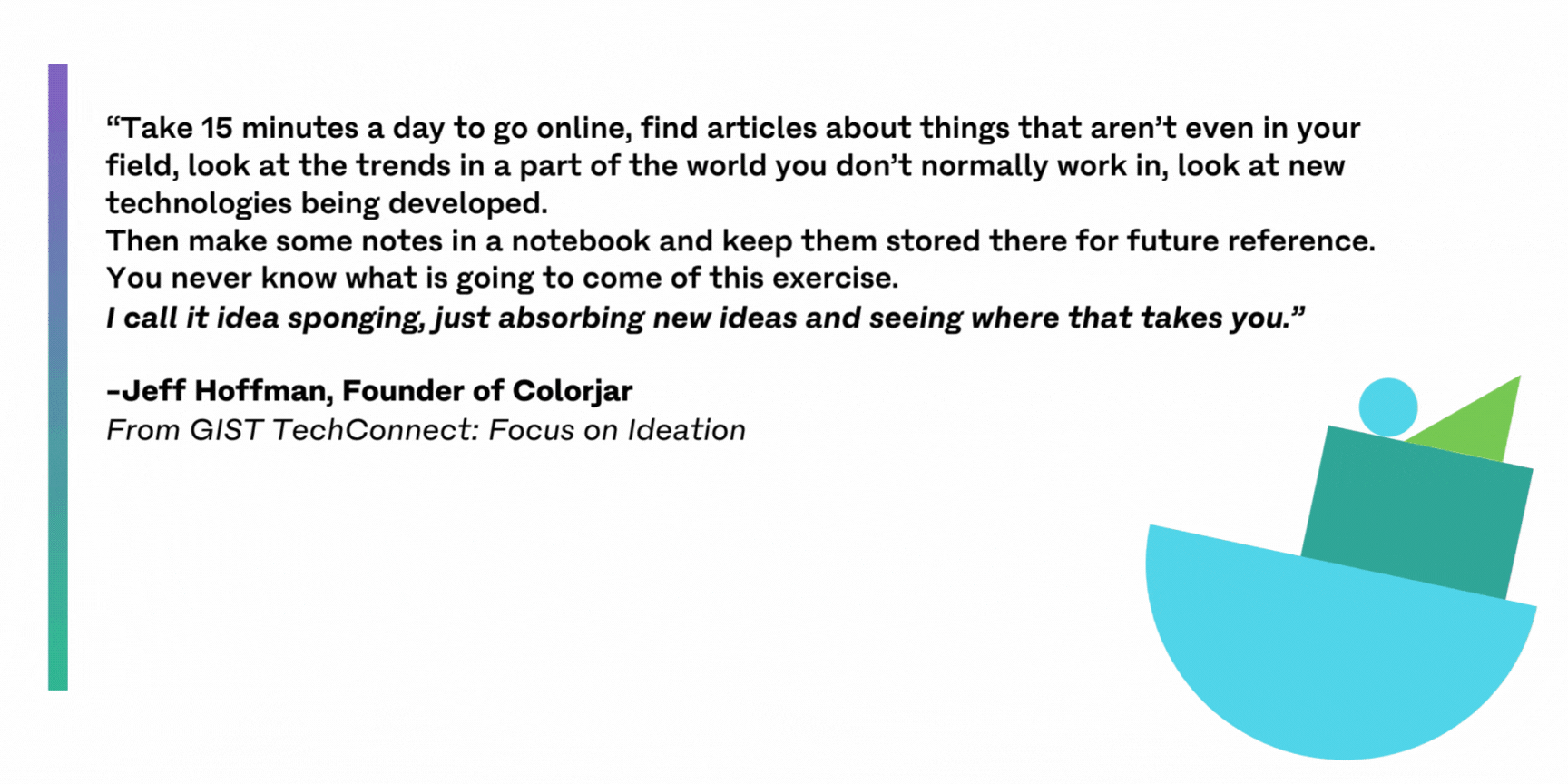Innovation Through Ideation
How Ideation Can Transform Science and Tech Startups
Drones that can monitor illegal mining, suits that can make someone impervious to fire… these are just some of the extraordinary innovations we’ve seen science and technology entrepreneurs around the world come up with. Where do these incredible ideas come from? What makes a startup-worthy idea? While some innovators make this process look easy, the myth that great ideas are just a sudden stroke of genius is well, just that: a myth.
The truth is that anyone can come up with a great idea, and that all creator's paths for generating these ideas are shockingly similar, even despite huge differences in field or discipline.
This process is called “Ideation”, and chances are, you’ve probably already done something like it! What great entrepreneurs know however, is that this process can be studied and repeated, and can be built into your startup from the ground up. So you don’t need to worry about having a good idea only once- you can have one again and again.
Ideation pushes us beyond the realm of a “stroke of genius”; with it, we realize that coming up with great ideas is as much a science as an art, and like all science, anyone can study it and every person can create something meaningful.

How does Ideation work to help startups?
So what exactly is “Ideation”? We can start with the word itself, the result of combining the phrase ‘idea generation’. Ideation encompasses all the research, creative planning, and testing needed in order for an idea to become actualized. Ideation refers to the process of generating ideas; in the context of science and technology startups and entrepreneurship, ideation is the foundation for creating new products and services that solve problems and meet customer needs. It helps entrepreneurs identify opportunities, generate new ideas, and explore the potential of these ideas. It means identifying the most promising concepts and developing them into viable products and services.
The ideation process is usually thought of as divided into three parts: Idea generation (think brainstorming!), idea evaluation and selection (picking the best ones), and idea refinement and development.

How does Design Thinking support the Ideation process?
Idea generation can feel like the most open-ended part. After all, we all daydream, right? Not so! This too is a process, and you can maximize the way you approach it for you and your entire team to come up with better ideas, more quickly and more often. One way to do this is through “Design Thinking”, a concept that goes hand in hand with the Ideation process. Design thinking is a problem-solving approach that involves understanding the needs of customers and developing solutions that meet those needs. It is a customer-centric approach that focuses on empathy, experimentation, and iteration. It puts people first, focusing on the context of why someone has a problem, what that problem means to them, and what your solution should really accomplish. Like the famous truism goes, the customer doesn’t want a drill–they want a hole. Design thinking shifts the focus from a business-centric engineering solution, like inventing a product based on a bunch of assumptions and just hoping that it will work for customers, to a customer-centric solution: exploring cultural phenomena, observing how people behave and think, gaining insights into what they need, and designing a product around that.
While this sounds simple enough, innovators in science and technology can struggle with this, as we are oftentimes so focused on the technical side of innovation. The best entrepreneurs however, know that the “how” of a product working is just as important as the “why”. To truly understand this, and to be truly human-centered, you need to watch how people use a product or service and continue to refine the product or service in order to improve the consumer’s experience. This is the “iterative” part of design thinking. It means moving quickly to get prototypes out to test, rather than endless research or rumination- the testing informs the refining, informs the brainstorming, informs the questions being asked and problems being solved; at its best, it works as one continuous loop.

What roles does a startup’s culture play in its Ideation?
In this way, Ideation is not just about the ideas. It’s also about the culture it nurtures in your organization. It creates a supportive environment, a space that encourages creativity and fosters open and honest communication. Through brainstorming sessions, idea jams, or other methods that encourage the exchange of ideas, it is important for entrepreneurs to create an environment that is free from criticism and allows individuals to share their ideas without fear of judgment. It is built on embracing diversity and encouraging idea generation from a wide range of sources. Science and technology startups often face complex problems, and by tapping into a wide range of perspectives and experiences, entrepreneurs can identify new opportunities and generate more creative and effective solutions. Encouraging idea generation from a diverse group of individuals helps entrepreneurs identify and address potential biases and blind spots in their thinking.
The importance of Ideation and Design Thinking isn’t just theoretical. Leading consulting firm McKinsey conducted research on this exact subject, and found that there was a strong correlation between high design thinking scores and superior business performance. Top-quartile design scorers increased their revenues and total returns to shareholders (TRS) substantially faster than their industry counterparts did over a five-year period—32 percentage points higher revenue growth and 56 percentage points higher TRS growth for the period as a whole.
Importantly, these results held true in all three of the industries they looked at: medical technology, consumer goods, and retail banking. This suggests that good design matters whether your company focuses on physical goods, digital products, services, or some combination of these.

We’ve found this to be just as true across the GIST Network as well, with founders from extremely different backgrounds and with very different problems to solve and solutions to create all sharing the value of this approach. GIST Innovator Ting Shih went through exactly this process of testing and refining. She had been looking at the issue of people in rural areas not having access to healthcare services. She and her team looked at the available resources and discovered that most people in rural areas had mobile phones, leading to brainstorming ways that people could use their phones to receive needed healthcare. Ting’s team determined that they could create a network of health providers and an online system to connect those providers to patients via mobile phone, a cutting edge and novel solution in 2010 when the company was forming. The team then needed to test the system’s biggest limiting factor: internet speeds. Would rural areas have fast enough internet speeds to support telehealth? Her team went to rural communities in Africa, places with the slowest internet connections, and tested the system, working with stakeholders at different levels and the human context of receiving this care. This allowed them to discover that connectivity was not going to be a limiting factor, and in fact, they began treating new patients through the system while doing this testing. She shares this perspective: “Understand who your actual customer is going to be. You might think it is the individual person affected by the issue you are trying to solve. But in fact it may be a larger agency or even industry that you need to work with in order to get your product in the hands of the end user.”

Innovation can be tough. It can be hard to come up with ideas, let alone test them- and it can be even harder to change your ideas when you find they aren’t working the way you thought they would. When Ideation is a part of your innovation process however, it can take a lot of this guesswork, a lot of the sometimes scary uncertainty out of the journey, and gives you the tools to make informed decisions and strategies in real time, in a way that’s not only effective, but can often be really fun, and allows you to translate that delight to your customer.
Stay tuned for more on this topic from GIST, and catch up on some of our previous resources. We have had some really amazing panelists and guests who have shared their knowledge and expertise with us, and you can get more information on this topic as well as so many others, below!
GIST TechConnect: Developing Your Roadmap to Startup Success!
Whether it’s team building, fundraising, marketing, or product development, building a strong network to utilize can be critical for startup success. But how do you build a strong network? What resources might already be available to you? And then, once the network is built, how do you use that network to achieve your goals? We answer those questions, and more, to give you the tools to build your own network and maximize its potential.
Learn more!
GIST TechConnect: Build a Startup From the Ground Up
There are many approaches to launching and growing a successful venture. Clearing the hurdles on your path to success—from developing the idea for your solution, to determining product/market fit, to overcoming gender bias — can be daunting. We sit down with a group of impactful entrepreneurs who share the strategies, best practices, and tips that early-stage innovators can use to set them on a path to growth and success.
Learn more!
https://www.gistnetwork.org/activity/gist-techconnect-building-startup-ground
Startup Resources: Focusing on Ideation
Where do great startup ideas come from and how can you bring your idea to market? In this condensed discussion, expert panelists explore idea formation and validation.
Learn More!
https://www.gistnetwork.org/startup-resources-focus-ideation
GIST TechConnect: Innovative Problem Solving with Limited Resources
Building a successful science and technology startup is challenging, even in the most developed startup ecosystems. For entrepreneurs who are not in these ecosystems – entrepreneurs who have limited access to capital, a strong network, government and industry support, or limited infrastructure – creating a startup is even more challenging.
However, there are entrepreneurs who have been able to launch and scale startups despite these challenges. These entrepreneurs understood how to leverage their limited resources to solve problems in their ecosystems. In doing so, these entrepreneurs created unique opportunities that helped them grow.
Now it is your turn to do the same. Join our panel of growth experts on the next GIST TechConnect, as they discuss how entrepreneurs with limited resources can overcome challenges facing their startups:
https://www.gistnetwork.org/node/23051
GIST TechConnect: Product Market Fit
Determining product market fit has been identified as a first step to building a successful venture, particularly as investors are increasingly attuned to whether a startup’s business model has evaluated whether there is a fit for the startup’s product to the market.
Learn More!
https://www.gistnetwork.org/gist-techconnect-product-market-fit